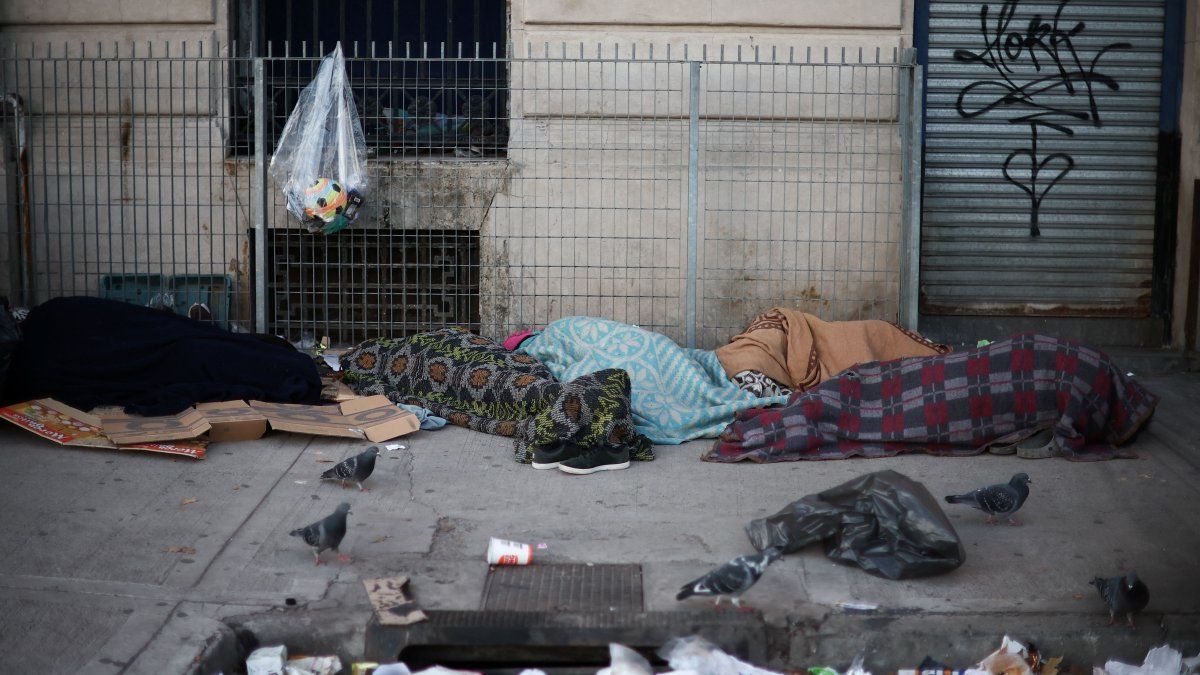The indicator published by the National Institute of Statistics and Censuses (INDEC) reflected a semi-annual increase of 11.2 points above the 41.7% at the end of last year. The indigence climbed from 11.9% to 18.1%.
A total of 17 of the 30 urban agglomerations are above the national index. Endurance, the capital of Chaco, headed the list of urban conglomerates with the highest poverty rate, with the 76.2%, more than 24 points above the national average. Three out of four people (323,504) They are below the minimum threshold stipulated to not be considered poor.
The city of Formosa placed second with 67.6% (177,821 people), followed by La Rioja 66.4% (156,893), Concordia (Entre Ríos) with 65.8% (108,890) and Santiago del Estero with 64% (266,265).
Then they follow the city of Santa Fe with the 59.8% (329,123), the parties of Greater Buenos Aires with a 59.7% (7,741,446), Viedma-Carmen de Patagones with the 56.7% (48,866), Inns with 55.9% (217,204) and Greater Catamarca with 55.9% (130,090), which closes the list of the first ten.
Poverty in Argentina, city by city
- Resistance: 76.2% (+15.9 points year-on-year)
- Formosa: 67.6% (+37.9)
- La Rioja: 66.4% (+26.8)
- Concordia (Entre Ríos): 65.8% (+7.5)
- Santiago del Estero: 64% (+17.4)
- Santa Fe: 59.8% (+16.8)
- Greater Buenos Aires: 59.7% (+12.7)
- Viedma-Carmen de Patagones: 56.7% (+13)
- Inns: 55.9% (+20)
- Greater Catamarca: 55.9% (+15.7)
- Gran Tucumán-Tafí Viejo: 55.8% (+14.6)
- Jujuy-Palpalá: 55.7% (+13.5)
- Rawson-Trelew: 55.5% (+12.8)
- San Nicolás-Villa Constitución: 55.2% (+14.8)
- Río Cuarto: 54.3% (+16.9)
- Greater St. Louis: 53.8% (+6.5)
- Río Gallegos: 53.8% (+20.3)
- Greater Mendoza: 52.9% (+11.1)
- Currents: 52.3% (+15.9)
- Jump: 52.2% (+14.7)
- Comodoro Rivadavia-Rada Tilly: 51.5% (+23.5)
- Greater La Plata: 51.2% (+16.2)
- Greater San Juan: 50.5% (+14.7)
- Greater Córdoba: 49.5% (10.4)
- Ushuaia-Río Grande: 48.6% (+23.2)
- Greater Rosario: 46.8% (+13.3)
- Greater Paraná: 46.7% (+12.4)
- Mar del Plata: 46.2% (+14.7)
- Bahía Blanca-Cerri: 44.4% (+10.2)
- Neuquén-Plottier: 40.4 (+6.1)
- Santa Rosa-Toay: 40.0 (+5)
- City of Buenos Aires: 23.1% (+5.8)
“The average total family income of poor households was $407,171,” INDEC reported this afternoon, while the average Total Basic Basket of the same group of households reached $709,318. The household poverty gap was 42.6%.
The highest incidences of poverty in people were observed in the regions Northeast (NEA) with a 62.9%, and the Northwest (NOA), with 57.0%. While the minor ones were registered in the regions Patagonia (49.1%) and Pampeana (49.9%). “In the agglomerations of 500,000 or more inhabitants, an increase in poverty of 11.0 pp was observed., while in the aglomerates of less than 500,000 the increase is 12.3 pp with respect to the second half of 2023,” the agency reported.
Regarding the level of Indigence, understood as those people whose income is not enough to buy the minimum amount of food to survive, with an average of 18.1% at the country level, Endurance was located in the stop with the 38.6%. They followed him Concord, with the 26.4%, Santiago del Estero 22.9%; Greater Buenos Aires 22.7%; and the Buenos Aires axis of San Nicolás-Villa Constitución, 22.1%, the organization reported.
“Given that the incidence of poverty and indigence results from the capacity of households to access the basic food basket (CBA) and the total basic basket (CBT) through their monetary income, it was observed that, with respect to the previous semester : On average, Total family income increased by 87.8%. The average regional baskets increased 115.3% (CBA) and 119.3% (CBT)“reported INDEC.
Between the end of 2023 and June of this year, inflation reached 79.8%, and although the Salary Index increased 84.3% in the first half of the year, not all employees had the same increase. Only registered workers in the private sector had an increase above inflation, registering an increase of 93.6%, while the income of public employees increased 73.3% and that of “black” workers 69%. .8%, reported the Indec.
In addition, during the first semester there was a 3.2% drop in the level of economic activity, and the unemployment rate went from 5.7% at the end of 2023 to 7.6% at the end of June. according to data from Index
Source: Ambito
I am an author and journalist who has worked in the entertainment industry for over a decade. I currently work as a news editor at a major news website, and my focus is on covering the latest trends in entertainment. I also write occasional pieces for other outlets, and have authored two books about the entertainment industry.




